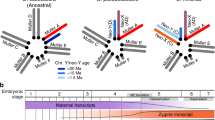Abstract
Position-effect variegation is the inactivation in some cells of a gene translocated next to heterochromatin, the region of the chromosome that is permanently condensed. The number of copies of the Drosophila gene Suvar(3)7 is a dose-limiting factor in this phenomenon, and seems from its sequence that it encodes a protein with five widely spaced zinc-fingers. This novel arrangement of zinc-fingers could help in packaging the chromatin fibre into heterochromatin, and also reflect a novel method of controlling the expression from DNA domains.
This is a preview of subscription content, access via your institution
Access options
Subscribe to this journal
Receive 51 print issues and online access
$199.00 per year
only $3.90 per issue
Buy this article
- Purchase on Springer Link
- Instant access to full article PDF
Prices may be subject to local taxes which are calculated during checkout
Similar content being viewed by others
References
Baker, W. K. Adv. Genet. 14, 133–169 (1968).
Spofford, J. B. in The Genetics and Biology of Drosophila Vol. 1c eds. Ashburner, M. & Novitski, E. 955–1018 (Academic. New York, 1976).
Russell, L. B. Science 140, 976–978 (1963).
Spofford, J. Genetics 57, 751–768 (1967).
Henikoff, S. Genetics 93, 105–115 (1979).
Reuter, G. & Wolff, I. Molec. gen. Genet. 182, 516–519 (1981).
Sinclair, D. A. R., Mottus, R. C. & Grigliatti, T. A. Molec. gen. Genet. 182, 516–519 (1981).
Reuter, G. et al. Molec. gen. Genet. 210, 429–436 (1987).
Bender, W., Spierer, P. & Hogness, D. S. J. molec. Biol. 186, 17–33 (1983).
Wustmann, G., Szidonya, J., Taubert, H. & Reuter, G. Molec. gen. Genet. 217, 520–517 (1989).
Reuter, G., Dorn, R., Wustmann, G., Friede, B. & Rauh, G. Molec. gen. Genet. 202, 481–487 (1986).
Gausz, J., Hall, L. M. C., Spierer, A. & Spierer, P. Genetics 112, 65–78 (1986).
Rubin, G. & Spradling A. C. Science 218, 348–353 (1982).
Robertson, H. M. et al Genetics 118, 461–470 (1988).
Reuter, G., Dorn, R. & Hoffmann, H. J. Molec. gen. Genet. 148, 480–485 (1982).
Candido, E. P. M., Reeves, R. & Davie, J. R. Cell 14, 105–113 (1978).
Sealy, L. & Chalkley, R. Cell 14, 115–121 (1978).
Hall, L. M. C., Mason, P. J. & Spierer, P. J. molec. Biol. 169, 83–96 (1983).
Struhl, K. Trends biochem. Sci. 14, 137–140 (1989).
Bairoch, A. PC/Gene Software (University of Geneva, TM IntelliGenetics Inc. and Genofit SA, 1989).
Locke, J., Kotarsky, M. A. & Tartoff, K. D. Genetics 120, 181–198 (1988).
Gasser, S. M. & Laemmli, U. K. Trends Genet. 13, 16–22 (1987).
Dingwall, C. et al. EMBO J. 6, 69–74 (1987).
Bourbon, H., Lapeyre, B. & Amalric, F. J. molec. Biol. 200, 627–638 (1988).
James, T. C. & Elgin, S. C. R. Molec. cell. Biol. 6, 3862–3872 (1986).
Eissenberg, J. C. BioEssays 11, 14–17 (1989).
Yamamoto, K. K., Gonzalez, G.A., Biggs III, W. H. & Montminy, M. R. Nature 334, 494–498 (1988).
Peifer, M., Karch, F. & Bender, W. Genes Dev. 1, 891–198 (1987).
Lewis, J. Nature 341, 382–383 (1989).
Struhl, G. Nature 308, 454–457 (1984).
Zink, B. & Paro, R. Nature 337, 468–471 (1989).
Duncan, I. & Lewis, E. B. in Developmental Order: Its Origin and Regulation (ed. Subtelny, S.) 533–554 (Liss, New York, 1982).
Dorn, R., Heymann, S., Lindigheit, R. & Reuter, G. Chromosoma 93, 398–403 (1986).
Fournier, D., Karch, F., Bride, J.-M., Hall, L. M. C., Bergé, J.-B. & Spierer, P. J. molec. Biol. 210, 15–22 (1989).
Nagoshi, R. N. & Gelbart, W. M. Genetics 117, 487–502 (1987).
Author information
Authors and Affiliations
Rights and permissions
About this article
Cite this article
Reuter, G., Giarre, M., Farah, J. et al. Dependence of position-effect variegation in Drosophila on dose of a gene encoding an unusual zinc-finger protein. Nature 344, 219–223 (1990). https://doi.org/10.1038/344219a0
Received:
Accepted:
Issue Date:
DOI: https://doi.org/10.1038/344219a0
This article is cited by
-
Heritable shifts in redox metabolites during mitochondrial quiescence reprogramme progeny metabolism
Nature Metabolism (2021)
-
Transgenerational effect of drug-mediated inhibition of LSD1 on eye pigment expression in Drosophila
BMC Ecology (2020)
-
Transcriptomic data from panarthropods shed new light on the evolution of insulator binding proteins in insects
BMC Genomics (2016)
-
The p53 target Wig-1: a regulator of mRNA stability and stem cell fate?
Cell Death & Differentiation (2011)
-
The Phylogenetic Distribution of Non-CTCF Insulator Proteins Is Limited to Insects and Reveals that BEAF-32 Is Drosophila Lineage Specific
Journal of Molecular Evolution (2010)
Comments
By submitting a comment you agree to abide by our Terms and Community Guidelines. If you find something abusive or that does not comply with our terms or guidelines please flag it as inappropriate.



